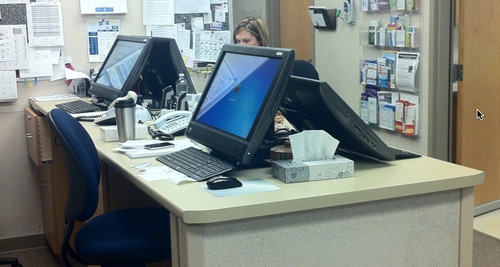For the paperless, cloud-connected medical office, backup Internet access is essential.

Just as the afternoon clinic session began, all of our clinic phones and Internet connectivity froze, stopping us in our tracks. Our clinic has been virtually paperless for several years and fully reliant on the Internet and phones to connect with data servers and call center.
Trouble is, we couldn’t remember the last time we had gone down. Yeah, there was that day several years ago when the main power supply to the town was cut but that left the whole town dark. No disaster: everybody had a day off. This time, everything was working except the phones and computers. Power was on and scheduled patients were coming in the door. We were left with no way to let scheduled patients know we’re in crisis mode and give them the opportunity to reschedule. Now this was a disaster!
Spasmodically we all whipped out our mobile phones and began finding out:
What caused the outage?
How long was it going to last?
What were we to do?
Within a minute we pieced together the following:
The backhoe we could see out the window at a nearby construction site had severed the fiber optic cable that fed most of our town,
Local telecom provider had no idea how long connectivity would be down, and
We were to initiate downtime procedures.
Downtime procedures? The manual said to revert to paper visit forms and scripts to process patients. We would then check in and backfill data in by scanning these into the chart when the system was restored. We were fortunately able to find the stack of paper visit notes and script pads gathering dust way in the back of our stock room.
These in hand, we re-entered exam rooms feeling naked, vulnerable, and fraudulent. These blank forms didn’t contain any of the information needed to make clinical decisions: no patient histories, allergies, problems, medications, overdue health maintenance, and a host of other things on which we were so reliant. In fact, so much information was missing we all shuddered with the realization we’d have to double the time for each visit in order to work with the patient to recall as much as we could. To top it off, we’d all but forgotten how to handle a patient visit using paper. Not unlike trying to remember how to properly fill out a paper check.
I had to pull out my cell phone less than a minute into the first paper visit in order to answer the patient’s question about a medication he was taking. As the visit progressed, it was embarrassing not to be able to answer many of the patient’s questions. I couldn’t remember anything about him from the last visit six months ago. I kept staring stupidly at the empty paper visit note and the frozen computer screen. Laughing in frustration, I let the patient know my dilemma. He joined in the laughter as he couldn’t remember either, and he was the patient!
We finally got through most of the visit and settled on a medication and referral. I picked up the pen and nervously started to spell out a prescription on the foreign looking paper script pad beside the iPhone that we’d used several times during the visit. Hmmm. The iPhone!
“Do you mind if I try something?” I asked the patient.
“My time, your dime, doc,” he said, more than a bit amused at my discomfort as well as curious about what I was going to do.
It took only a couple of seconds to turn on the personal hotspot, and in less than a minute had the HP9300t all-in-one standard exam room device as well as my laptop back on the web and connected to our remote hosted EMR. I quickly logged in, selected the script, and sent it to the pharmacy that was fortunately about 30 blocks away. The only thing I couldn’t do was to give him the visit summary, as all of our printers are hard wired to the network (which, of course, was dark).
Coming out of the room, I showed the other providers how to turn on their personal hotspots. For some, this was the first time they’d ever used this functionality. Soon, we had all of the exam room devices as well as the other 12 all-in-one desktops up and humming on the backs of 5 smartphones.
The only problem was the reception area devices were all fixed desk units without wireless cards. We were able to find a couple of laptops with wireless cards for them. So before each of us finished with that first patient of the afternoon, we were back live while many of the nearby business were stymied, waiting for phone and Internet service to be restored.
Lessons learned:
Smartphones with personal hotspot capabilities should be an integral part of any disaster preparedness plan.
All computing devices should have wireless capabilities to leverage these emergency hotspots.
Keep the data and application servers in the cloud, protected from local backhoes.
The other thing we discovered was that those phones with AT&T plans could receive and send voice calls without cutting off the access points other computers were using while those on Verizon plans had to reconnect after that phone was used for a voice session.
With data in the cloud and iPhones in hand, we only suffered a brief delay and avoided a true disaster, as it took the remainder of the afternoon before service was restored.
Remote Patient Monitoring: Don't let all those Fitbits fool you. Though remote monitoring technology is sound, it's still far from widespread clinical adoption. Read the new InformationWeek Healthcare Digital Issue.
About the Author(s)
You May Also Like







